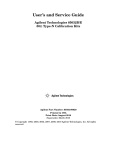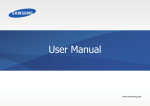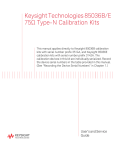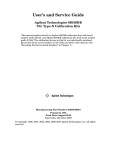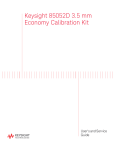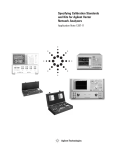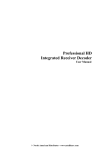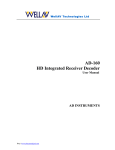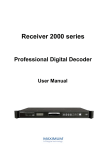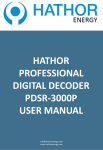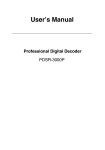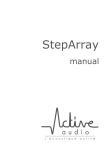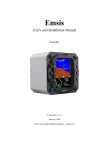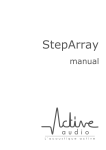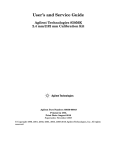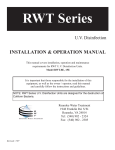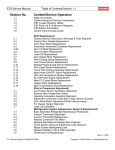Download Agilent Technologies 85059A 1.0 mm Precision Calibration and
Transcript
Agilent Technologies 85059A 1.0 mm Precision Calibration and Verification Kit Operating and Service Manual Agilent Part Number: 85059-90003 Printed in USA Print Date: August 2013 Supersedes: August 2012 © Copyright 2000, 2010, 2012, 2013 Agilent Technologies Inc. All rights reserved. -ii Agilent Technologies 85059A 1.0 mm Calibration and Verification Kit Documentation Warranty THE MATERIAL CONTAINED IN THIS DOCUMENT IS PROVIDED "AS IS," AND IS SUBJECT TO BEING CHANGED, WITHOUT NOTICE, IN FUTURE EDITIONS. FURTHER, TO THE MAXIMUM EXTENT PERMITTED BY APPLICABLE LAW, AGILENT DISCLAIMS ALL WARRANTIES, EITHER EXPRESS OR IMPLIED WITH REGARD TO THIS MANUAL AND ANY INFORMATION CONTAINED HEREIN, INCLUDING BUT NOT LIMITED TO THE IMPLIED WARRANTIES OF MERCHANTABILITY AND FITNESS FOR A PARTICULAR PURPOSE. AGILENT SHALL NOT BE LIABLE FOR ERRORS OR FOR INCIDENTAL OR CONSEQUENTIAL DAMAGES IN CONNECTION WITH THE FURNISHING, USE, OR PERFORMANCE OF THIS DOCUMENT OR ANY INFORMATION CONTAINED HEREIN. SHOULD AGILENT AND THE USER HAVE A SEPARATE WRITTEN AGREEMENT WITH WARRANTY TERMS COVERING THE MATERIAL IN THIS DOCUMENT THAT CONFLICT WITH THESE TERMS, THE WARRANTY TERMS IN THE SEPARATE AGREEMENT WILL CONTROL. iii 85059A 1.0 mm Calibration and Verification Kit DFARS/Restricted Rights Notice If software is for use in the performance of a U.S. Government prime contract or subcontract, Software is delivered and licensed as “Commercial computer software” as defined in DFAR 252.227-7014 (June 1995), or as a “commercial item” as defined in FAR 2.101(a) or as “Restricted computer software” as defined in FAR 52.227-19 (June 1987) or any equivalent agency regulation or contract clause. Use, duplication or disclosure of Software is subject to Agilent Technologies’ standard commercial license terms, and non-DOD Departments and Agencies of the U.S. Government will receive no greater than Restricted Rights as defined in FAR 52.227-19(c)(1-2) (June 1987). U.S. Government users will receive no greater than Limited Rights as defined in FAR 52.227-14 (June 1987) or DFAR 252.227-7015 (b)(2) (November 1995), as applicable in any technical data. 85059A 1.0 mm Calibration and Verification Kit iv Assistance Product maintenance agreements and other customer assistance agreements are available for Agilent products. For any assistance, contact Agilent Technologies. Refer to “Contacting Agilent” on page 6-2. v 85059A 1.0 mm Calibration and Verification Kit Printing Copies of Documentation from the Web To print copies of documentation from the Web, download the PDF file from the Agilent web site: • Go to www.agilent.com. • Enter the document’s part number (located on the title page) in the Search box. • Click Search. • Open the PDF and print the document. 85059A 1.0 mm Calibration and Verification Kit vi Contents Documentation Warranty . . . . . . . . . . . . . . . . . . . . . . . . . . . . . . . . . . . . . . . . . . . . iii DFARS/Restricted Rights Notice . . . . . . . . . . . . . . . . . . . . . . . . . . . . . . . . . . . . . . iv Assistance . . . . . . . . . . . . . . . . . . . . . . . . . . . . . . . . . . . . . . . . . . . . . . . . . . . . . . . . . . v Printing Copies of Documentation from the Web . . . . . . . . . . . . . . . . . . . . . . . . vi What You’ll Find in This Manual… . . . . . . . . . . . . . . . . . . . . . . . . . . . . . . . . . . . . . vii 1. General Information Calibration and Verification Kit Overview . . . . . . . . . . . . . . . . . . . . . . . . . . 1-1 About This Manual . . . . . . . . . . . . . . . . . . . . . . . . . . . . . . . . . . . . . . . . . . . . . 1-2 Make Backup Copies . . . . . . . . . . . . . . . . . . . . . . . . . . . . . . . . . . . . . . . . . . . 1-2 How To Identify Shorts . . . . . . . . . . . . . . . . . . . . . . . . . . . . . . . . . . . . . . . . . . 1-2 Kit Contents . . . . . . . . . . . . . . . . . . . . . . . . . . . . . . . . . . . . . . . . . . . . . . . . . . . 1-2 Compatible Network Analyzers . . . . . . . . . . . . . . . . . . . . . . . . . . . . . . . . . . . 1-2 Achieving Specified Frequency Performance . . . . . . . . . . . . . . . . . . . . . . . . . . . 1-3 Calibration Standards . . . . . . . . . . . . . . . . . . . . . . . . . . . . . . . . . . . . . . . . . . . 1-3 Table 1-1. Calibration Techniques and Standards. . . . . . . . . . . . . . . . . . . . 1-3 Table 1-2. Broadband SOLT . . . . . . . . . . . . . . . . . . . . . . . . . . . . . . . . . . . . . . 1-4 Broadband Load Construction . . . . . . . . . . . . . . . . . . . . . . . . . . . . . . . . . . . 1-5 Figure 1-1. Lossy Delay Line (male end) Attached To 50 GHz Load (female end). . . . . . . . . . . . . . . . . . . . . . . . . . . . . . . . . . . . . . . . . . . . . . . . 1-5 Figure 1-2. Lossy Delay Line (female end) Attached To 50 GHz Load (male end) 1-5 Equipment Required but Not Supplied . . . . . . . . . . . . . . . . . . . . . . . . . . . . . . . . 1-6 Serial Numbers . . . . . . . . . . . . . . . . . . . . . . . . . . . . . . . . . . . . . . . . . . . . . . . . . . . . 1-7 Serial Number Prefix . . . . . . . . . . . . . . . . . . . . . . . . . . . . . . . . . . . . . . . . . . . . 1-7 Serial Number Suffix . . . . . . . . . . . . . . . . . . . . . . . . . . . . . . . . . . . . . . . . . . . . 1-7 Figure 1-3. Typical Kit Serial Number Label . . . . . . . . . . . . . . . . . . . . . . . 1-7 Device Serial Numbers . . . . . . . . . . . . . . . . . . . . . . . . . . . . . . . . . . . . . . . . . . 1-7 Table 1-3. Kit and Device Serial Number Record . . . . . . . . . . . . . . . . . . . . 1-8 Incoming Inspection . . . . . . . . . . . . . . . . . . . . . . . . . . . . . . . . . . . . . . . . . . . . . . . . 1-9 Clarifying Connector Gender . . . . . . . . . . . . . . . . . . . . . . . . . . . . . . . . . . . . . . . . 1-10 Figure 1-4. Clarifying Connector Gender . . . . . . . . . . . . . . . . . . . . . . . . . 1-10 Figure 1-5. Male and Female Connectors . . . . . . . . . . . . . . . . . . . . . . . . 1-10 Preventive Maintenance . . . . . . . . . . . . . . . . . . . . . . . . . . . . . . . . . . . . . . . . . . . 1-11 When to Calibrate . . . . . . . . . . . . . . . . . . . . . . . . . . . . . . . . . . . . . . . . . . . . . . . . . 1-12 2. Specifications Environmental Requirements . . . . . . . . . . . . . . . . . . . . . . . . . . . . . . . . . . . . . . . . Table 2-1. Environmental Requirements . . . . . . . . . . . . . . . . . . . . . . . . . . . Temperature - What to Watch Out For. . . . . . . . . . . . . . . . . . . . . . . . . . . . . . . . . Mechanical Characteristics . . . . . . . . . . . . . . . . . . . . . . . . . . . . . . . . . . . . . . . . . Supplemental Mechanical Characteristics . . . . . . . . . . . . . . . . . . . . . . . . . Table 2-2. Offset Short Typical Mechanical Characteristics . . . . . . . . . . . Center Conductor Protrusion and Pin Depth . . . . . . . . . . . . . . . . . . . . . . . . Electrical Characteristics . . . . . . . . . . . . . . . . . . . . . . . . . . . . . . . . . . . . . . . . . . . . Supplemental Electrical Characteristics . . . . . . . . . . . . . . . . . . . . . . . . . . . Table 2-3. Offset Short Electrical Characteristics. . . . . . . . . . . . . . . . . . 85059A 2-1 2-1 2-2 2-3 2-3 2-3 2-3 2-4 2-4 2-4 TOC i Contents Table 2-4. Adapter Electrical Characteristics . . . . . . . . . . . . . . . . . . . . . . . Electrical Specifications . . . . . . . . . . . . . . . . . . . . . . . . . . . . . . . . . . . . . . . . . . . . Table 2-5. Electrical Specifications for 1.0 mm 50W Devices . . . . . . . . . . Table 2-6. Typical Electrical Specifications for 1.0 mm 50W Devices. . . . 3. 2-4 2-5 2-5 2-6 Making Connections Electrostatic Discharge . . . . . . . . . . . . . . . . . . . . . . . . . . . . . . . . . . . . . . . . . . . . . 3-1 Visual Inspection . . . . . . . . . . . . . . . . . . . . . . . . . . . . . . . . . . . . . . . . . . . . . . . . . . 3-3 Obvious Defects or Damage . . . . . . . . . . . . . . . . . . . . . . . . . . . . . . . . . . . . . 3-3 Figure 3-1. Contact Integrity . . . . . . . . . . . . . . . . . . . . . . . . . . . . . . . . . . . . 3-4 Concentricity . . . . . . . . . . . . . . . . . . . . . . . . . . . . . . . . . . . . . . . . . . . . . . . . . . 3-4 Figure 3-2. Concentricity - Female Connector. . . . . . . . . . . . . . . . . . . . . . 3-4 Figure 3-3. Concentricity - Male Connector . . . . . . . . . . . . . . . . . . . . . . . 3-5 Mating Plane Surfaces . . . . . . . . . . . . . . . . . . . . . . . . . . . . . . . . . . . . . . . . . . 3-5 Supplies and Equipment Needed . . . . . . . . . . . . . . . . . . . . . . . . . . . . . . . . . 3-6 Pin Depth . . . . . . . . . . . . . . . . . . . . . . . . . . . . . . . . . . . . . . . . . . . . . . . . . . . . . . . . . 3-7 Protrusion and Recession . . . . . . . . . . . . . . . . . . . . . . . . . . . . . . . . . . . . . . . 3-7 Figure 3-4. Connector Pin Depth. . . . . . . . . . . . . . . . . . . . . . . . . . . . . . . . . 3-8 Making Connections . . . . . . . . . . . . . . . . . . . . . . . . . . . . . . . . . . . . . . . . . . . . . . . 3-9 Connection Procedure. . . . . . . . . . . . . . . . . . . . . . . . . . . . . . . . . . . . . . . . . . . 3-9 Figure 3-5. Alignment . . . . . . . . . . . . . . . . . . . . . . . . . . . . . . . . . . . . . . . . . 3-10 Connector Misalignment . . . . . . . . . . . . . . . . . . . . . . . . . . . . . . . . . . . . . . . 3-11 Figure 3-6. Misalignment . . . . . . . . . . . . . . . . . . . . . . . . . . . . . . . . . . . . . . 3-11 Cleaning Connectors . . . . . . . . . . . . . . . . . . . . . . . . . . . . . . . . . . . . . . . . . . . . . . 3-12 Supplies and Equipment Needed . . . . . . . . . . . . . . . . . . . . . . . . . . . . . . . . 3-12 Basic Cleaning Procedure . . . . . . . . . . . . . . . . . . . . . . . . . . . . . . . . . . . . . . 3-12 Figure 3-7. Cleaning Illustration . . . . . . . . . . . . . . . . . . . . . . . . . . . . . . . . 3-13 Making a Connection . . . . . . . . . . . . . . . . . . . . . . . . . . . . . . . . . . . . . . . . . . . . . . 3-13 Connection Procedure . . . . . . . . . . . . . . . . . . . . . . . . . . . . . . . . . . . . . . . . . 3-13 Using the Torque Wrench . . . . . . . . . . . . . . . . . . . . . . . . . . . . . . . . . . . . . . . . . . 3-14 Table 3-1. Torque Wrench Information . . . . . . . . . . . . . . . . . . . . . . . . . . . 3-14 Torque Wrench Procedure . . . . . . . . . . . . . . . . . . . . . . . . . . . . . . . . . . . . . . 3-14 Figure 3-8. Correct Wrench Position . . . . . . . . . . . . . . . . . . . . . . . . . . . . 3-15 Figure 3-9. Incorrect Wrench Position . . . . . . . . . . . . . . . . . . . . . . . . . . . 3-15 Figure 3-10. Where to Hold the Torque Wrench . . . . . . . . . . . . . . . . . . . 3-16 Figure 3-11. Using the Torque Wrench. . . . . . . . . . . . . . . . . . . . . . . . . . . 3-16 Disconnection Procedure . . . . . . . . . . . . . . . . . . . . . . . . . . . . . . . . . . . . . . . . . . 3-18 Handling and Storage . . . . . . . . . . . . . . . . . . . . . . . . . . . . . . . . . . . . . . . . . . . . . . 3-19 4. User Information Calibration and Verification Devices . . . . . . . . . . . . . . . . . . . . . . . . . . . . . . . . . . Offset Opens and Shorts . . . . . . . . . . . . . . . . . . . . . . . . . . . . . . . . . . . . . . . . Offset Shorts (3 rings) . . . . . . . . . . . . . . . . . . . . . . . . . . . . . . . . . . . . . . . . . . Verification Devices . . . . . . . . . . . . . . . . . . . . . . . . . . . . . . . . . . . . . . . . . . . . Adapters . . . . . . . . . . . . . . . . . . . . . . . . . . . . . . . . . . . . . . . . . . . . . . . . . . . . . . Loads . . . . . . . . . . . . . . . . . . . . . . . . . . . . . . . . . . . . . . . . . . . . . . . . . . . . . . . . . TOC ii 4-1 4-1 4-1 4-1 4-2 4-2 85059A Contents 5. Performance Verification System Verification . . . . . . . . . . . . . . . . . . . . . . . . . . . . . . . . . . . . . . . . . . . . . . . . . Calibration Kit Verification . . . . . . . . . . . . . . . . . . . . . . . . . . . . . . . . . . . . . . . . . . . What Recertification Provides . . . . . . . . . . . . . . . . . . . . . . . . . . . . . . . . . . . . . . . How Often to Recertify . . . . . . . . . . . . . . . . . . . . . . . . . . . . . . . . . . . . . . . . . . . . . Where to Send a Kit for Recertification . . . . . . . . . . . . . . . . . . . . . . . . . . . . . . . . How Agilent Technologies Verifies Devices in this Kit . . . . . . . . . . . . . . . . . . . 6. Troubleshooting Returning a Kit or Device to Agilent Technologies . . . . . . . . . . . . . . . . . . . . . . Where To Look For More Information . . . . . . . . . . . . . . . . . . . . . . . . . . . . . . . . . Contacting Agilent . . . . . . . . . . . . . . . . . . . . . . . . . . . . . . . . . . . . . . . . . . . . . . . . . Figure 6-1. Troubleshooting Flowchart. . . . . . . . . . . . . . . . . . . . . . . . . . . . 7. 5-1 5-1 5-1 5-1 5-2 5-2 6-1 6-1 6-1 6-2 Replaceable Parts Replacing the Verification Data . . . . . . . . . . . . . . . . . . . . . . . . . . . . . . . . . . . . . . 7-1 Table 7-1. Replaceable Parts . . . . . . . . . . . . . . . . . . . . . . . . . . . . . . . . . . . . 7-2 8. Standard Definitions Class Assignments and Standard Definitions Values are Available on the Web . . . . . . . . . . . . . . . . . . . . . . . . . . . . . . . . . . . . . . . . . . . . . . . . . . . . . . . . . 8-1 85059A TOC iii Contents TOC iv 85059A 1 General Information Calibration and Verification Kit Overview The 85059A 1.0 mm precision calibration and verification kit is used to calibrate and verify your PNA series network analyzer system. This kit is used for the measurement of components with 50 1.0 mm connectors with a frequency range of DC to 110 GHz. Because it is physically impossible to construct a slotless version of the 1.0 mm female contact, the female devices in this kit use slotted contacts. The slotted female contact does not have the same electrical characteristics as a solid conductor, and therefore, the male and female devices in this kit have different coefficients. Although the male and female devices are designed to have the same mechanical length, their electrical delays are different. This reflects the differences in the connector interface compression. When the male and female devices are torqued together the male side compresses more than the female side. The 1.0 mm connector utilizes an air dielectric interface for the highest accuracy and repeatability. The coupling diameter and thread size were chosen to maximize strength, increase durability and provide highly repeatable connections. The connectors are designed so that the outer conductors engage before the center conductors. To obtain the best performance possible, the manufacturing tolerances of the connectors are tighter than the standard 1.0 mm specifications per the IEEE 287 precision connector standard. The verification kit provides a set of standards with known characteristics, traceable to primary standards in the Agilent Technologies calibration lab. This set of standards is used to verify your measurement calibration and also to verify that your PNA system is operating within its specifications. The kit includes the following verification items: • Mismatched thru adapter • Matched thru adapter • USB drive that contains factory-measured verification data • Data sheet for each device that contains factory-measured verification data • Anti-virus scan report 85059A 1.0 mm Calibration and Verification Kit 1-1 General Information About This Manual This manual describes the 85059A calibration and verification kit and provides replacement part numbers, specifications, and procedures for using, maintaining and troubleshooting this kit. Make Backup Copies Backup copies of the data sheets, anti-virus scan reports, and the data on the USB drive should be made immediately upon receipt of the verification kit. A file containing the verification data for your kit is maintained for one year from the time of measurement. If you lose this data, contact Agilent. How To Identify Shorts The shorts in this kit are identified by the number of rings (or bands) around the body of the short. • • • • 1.0 x 1.30 mm short has 1 ring or band and is identified as Short 1 1.0 x 1.825 mm short has 2 rings or bands and is identified as Short 2 1.0 x 2.45 mm short has 3 rings or bands and is identified as Short 3 1.0 x 3.0 mm short has 4 rings or bands and is identified as Short 4 Kit Contents Use the Contents List in the shipping container to verify the completeness of your shipment. Although this list is the most accurate, you can also use the illustration in Figure 7-1 on page 7-2 to verify the items in your shipment. If your shipment is not complete, contact Agilent Technologies - refer to “Contacting Agilent” on page 6-2. Compatible Network Analyzers The devices in this kit and their data are compatible with the PNA series network analyzers. The USB drive provided contains the unique factory-measured S-parameter data for each device in the kit. It also contains the factory measurement uncertainty used in the PNA system verification procedure to calculate the test limits. Older models of this verification kit provided data disks for the 8510, 8720, and 8722 network analyzers. Since these analyzers have been discontinued, the data disks are no longer provided. When old verification kits that include the data disks are returned to Agilent for recertification, the disks will be reproduced with new data for each device in the kit. Please specify your VNA model(s) when returning kits for service or when ordering kit replacement parts. 1-2 Agilent Technologies 85059A 1.0 mm Calibration and Verification Kit General Information Achieving Specified Frequency Performance Achieving Specified Frequency Performance The standards in this calibration and verification kit allow you to perform simple 1- or 2-port calibrations, as well as TRM (thru-reflect-match) calibrations, and to verify the performance of your PNA system. NOTE Above 50 GHz, offset shorts are substituted for the opens and loads. NOTE For best results, before beginning calibration refer to “Clarifying Connector Gender” on page 1-10. Calibration Standards Table 1-1 Calibration Techniques and Standards Frequency Range Calibration Technique “Open” Standard (Reflection) “Short” Standard (Reflection) “Load” Standard (Reflection) “Thru” Standard (not used for 1-port cal) “Isolation” Standard1 DC - 50 GHz SOLT2 Open Short 3 50 GHz Load Thru 50 GHz Load 50 - 75 GHz Offset Shorts Short 3 Short 1 Short 4 Thru Load BB3 75 - 110 GHz Offset Shorts Short 3 Short 1 Short 2 Thru Load BB3 To Combine Frequency Ranges4 DC - 75GHz SOLT2 and Offset Shorts Open Short 3 Short 3 Short 1 50 GHz Load Short 4 Thru Load BB3 50 - 110 GHz Offset Shorts Short 3 Short 1 Short 4 Short 2 Thru Load BB3 DC - 110 GHz SOLT2 and Offset Shorts Open Short 3 Short 3 Short 1 50 GHz Load Short 4 Short 2 Thru Load BB3 1. For best measurement results, the isolation standard should be the equivalent impedance of the device under test. 2. SOLT = Short, Open, Load and Thru standards 3. The broadband load is a combination of a lossy delay line plus a 50 GHz load (see Figures 1-1 and 1-2 on page 1-5). 4. Combinations of the calibration methods shown in the upper half of Table 1-1 are used to calibrate over the frequency ranges shown in the lower half of the table. 85059A 1.0 mm Calibration and Verification Kit 1-3 General Information Achieving Specified Frequency Performance Broadband SOLT Calibration As a time saver, you can use an alternate SOLT technique. You can calibrate from DC to 110 GHz using the standards in Table 1-2. The broadband SOLT technique is quicker than the full calibration outlined in Table 1-1 on page 1-3, but it is substantially less accurate. CAUTION The broadband SOLT technique is not recommended. It is meant to be used only in situations where measurement accuracy is not critical. Table 1-2 Broadband SOLT1 Frequency Range Calibration Technique “Open” Standard “Short” Standard “Load” Standard “Thru” Standard (not used for 1-port cal) “Isolation” Standard DC - 110 GHz SOLT1 Open (broadband) Short 3 (broadband) Load BB2 Thru Load BB3 1. SOLT = Short, Open, Load and Thru standards 2. The broadband load is a combination of a lossy delay line plus a 50 GHz load (see Figures 1-1 and 1-2 on page 1-5). 1-4 Agilent Technologies 85059A 1.0 mm Calibration and Verification Kit General Information Achieving Specified Frequency Performance Broadband Load Construction For broadband calibration it is necessary to add the Lossy Delay Line to the appropriate gender 50 GHz load (see Figures 1-1 and Figures 1-2). CAUTION The two Lossy delay lines in this kit are the same and may be used interchangeably. However, once they are mated with a particular 50 GHz load and the calibration sequence is started, the assembly should be considered a matched unit until the calibration has been completed. Lo Figure 1-1 Lossy Delay Line (male end) Attached To 50 GHz Load (female end) Figure 1-2 Lossy Delay Line (female end) Attached To 50 GHz Load (male end) 85059A 1.0 mm Calibration and Verification Kit 1-5 General Information Equipment Required but Not Supplied Equipment Required but Not Supplied Various connector cleaning supplies and electrostatic discharge safety supplies are not provided in this kit. (Refer to Chapter 7, “Replaceable Parts” for ordering information.) 1-6 Agilent Technologies 85059A 1.0 mm Calibration and Verification Kit General Information Serial Numbers Serial Numbers Serial Number Prefix A serial number label is attached to the calibration and verification kit. A typical kit serial number label is shown in Figures 1-3. The prefix is made up of six characters. The first two characters show the country, the next two digits represent the year, and the last two digits designate the week of manufacturing. Serial Number Suffix The last five digits are the suffix numbers. The suffix numbers are unique to each calibration kit. Figure 1-3 Typical Kit Serial Number Label Device Serial Numbers In addition to the kit serial number, the devices in this kit are individually serialized (serial numbers are printed on an attached label, or scribed onto the body of each device). Record these serial numbers in Table 1-3 on page 1-8. This can help you avoid confusing the devices in this kit with similar devices from other kits. 85059A 1.0 mm Calibration and Verification Kit 1-7 General Information Serial Numbers Serial Number Record Log Table 1-3 Kit and Device Serial Number Record Device Description Serial Number -m- Short 1 -f- Short 1 -m- Short 2 -f- Short 2 -m- Short 3 -f- Short 3 -m- Short 4 -f- Short 4 -m- Load -f- Load Lossy Delay Line (1) Lossy Delay Line (2) -m- Open -f- Open Mismatched Thru Adapter Matched Thru Adapter -m- to -m- Adapter -f- to -f- Adapter -m- to -f- Adapter 1-8 Agilent Technologies 85059A 1.0 mm Calibration and Verification Kit General Information Incoming Inspection Incoming Inspection The foam-lined storage case provides protection during shipping. If the case or any device appears damaged, contact Agilent Technologies - refer to “Contacting Agilent” on page 6-2. Agilent will arrange for repair or replacement of incomplete or damaged shipments without waiting for a settlement from the transportation company. When you send the kit or device to Agilent, include a service tag (located at the rear of this manual) on which you provide the following information: • • Your company name and address. • If you are returning a complete kit, include the model number and serial number. • If you are returning one or more devices, include the part numbers and serial numbers. • • Indicate the type of service required. A technical contact person within your company, and the person's complete phone number. Include any applicable information. 85059A 1.0 mm Calibration and Verification Kit 1-9 General Information Clarifying Connector Gender Clarifying Connector Gender In this manual, connectors are referred to in terms of their device gender unless otherwise stated. For example, a male open has a male connector. Figure 1-4 Clarifying Connector Gender Figure 1-5 Male and Female Connectors 1-10 Agilent Technologies 85059A 1.0 mm Calibration and Verification Kit General Information Preventive Maintenance Preventive Maintenance The best techniques for maintaining the integrity of the devices in this kit include routine visual inspection, cleaning and proper connection techniques. Failure to detect and remove dirt or metallic particles on a mating plane surface can degrade repeatability and accuracy, and can damage any connector mated to it. Improper connections resulting from poor connection techniques can also damage these devices. Visual inspection, cleaning techniques, and connection techniques are all described in Chapter 3, “Making Connections”. 85059A 1.0 mm Calibration and Verification Kit 1-11 General Information When to Calibrate When to Calibrate A PNA calibration remains valid as long as the changes in the systematic error are insignificant. This means that changes to the uncorrected leakages (directivity and isolation), mismatches (source match and load match), and frequency response of the system are small (<10%) relative to accuracy specifications. Change in the environment (especially temperature) between calibration and measurement is the major cause in calibration accuracy degradation. The major effect is a change in the physical length of external and internal cables. Other important causes are dirty and damaged test port connectors and calibration standards. If the connectors become dirty or damaged, measurement repeatability and accuracy is affected. Fortunately, it is relatively easy to evaluate the general validity of the calibration. To test repeatability, remeasure one of the calibration standards. If you can not obtain repeatable measurements from your calibration standards, maintenance needs to be performed on the test port connectors, cables and calibration standards. Also, maintain at least one sample of the device under test or some known device as your reference device. A verification kit may be used for this purpose. After calibration, measure the reference device and note its responses. Periodically remeasure the device and note any changes in its corrected response which can be attributed to the test system. With experience you will be able to see changes in the reference responses that indicate a need to perform the measurement calibration again. 1-12 Agilent Technologies 85059A 1.0 mm Calibration and Verification Kit 2 Specifications Environmental Requirements Table 2-1 shows the environmental requirements necessary for optimum performance. Table 2-1 Environmental Requirements Parameter Required Values/Ranges Operating Temperature 1 20 to 26C (68 tF Error-Corrected Temperature Range2 C of measurement calibration temperature Storage Temperature –40toC (–4tF) Relative Humidity Relative Humidity: Type tested, 0% to 95% at 40C, Non-Condensing 1. The temperature range over which the calibration standards maintain performance to their specifications. 2. The allowable network analyzer ambient temperature drift during measurement calibration and during measurements when the network analyzer correction is turned on. Also, the range over which the network analyzer maintains its specified performance while correction is turned on. 85059A 1.0 mm Calibration and Verification Kit 2-1 Specifications Temperature –What To Watch Out For Due to the small dimensions and tight tolerances of the calibration and verification devices, electrical characteristics will change with temperature. Therefore, the operating temperature is a critical factor in their performance. During a measurement calibration, the temperature of the calibration devices must be stable and within the range shown in Table 2-1 on page 2-1. NOTE Remember your fingers are a heat source, so avoid handling the devices unnecessarily during calibration. Performance verification and measurements of devices-under-test (DUT’s) do not need to be performed within the operating temperature range of the calibration devices. However, the DUT’s must be within the error-corrected temperature range of the network analyzer (1C of the measurement calibration temperature). For example, if the calibration is performed at +20C, the error-corrected temperature range is +19to +21C. It is then appropriate to perform measurements and performance verifications even though +19is outside the operating temperature range of the calibration devices. 2-2 Agilent Technologies 85059A 1.0 mm Calibration and Verification Kit Specifications Mechanical Characteristics Mechanical Characteristics Supplemental Mechanical Characteristics Supplemental mechanical characteristics are values which are typically met by the majority of calibration and verification kit devices that have been tested at Agilent Technologies. These supplemental characteristics are intended to provide useful information in calibration and verification kit applications. These are typical but non-warranted performance parameters. The following table lists the typical mechanical characteristics of the devices in this kit. Table 2-2 Center Conductor Protrusion and Pin Depth Offset Short Typical Mechanical Characteristics Characteristic Typical Value Inside Diameter of Outer Conductor 1.000 0.005 mm Outside Diameter of Center Conductor 0.434 0.003 mm Offset Length Nominal 0.008 mm Pin Depth 0 (flush) to 0.010 mm (maximum recession) Flatness of Reference Plane 0.002 mm (worst case) Mechanical characteristics such as center conductor protrusion and pin depth are not performance specifications. They are, however, important supplemental characteristics related to electrical performance. Agilent Technologies verifies the mechanical characteristics of the devices in this kit with special gaging processes and electrical testing. This ensures that the device connectors do not exhibit any center conductor protrusion and have proper pin depth when the kit leaves the factory. Agilent Technologies 85059A 1.0 mm Calibration and Verification Kit 2-3 Specifications Electrical Characteristics Electrical Characteristics Supplemental Electrical Characteristics Table 2-3 Offset Short Electrical Characteristics Characteristic Typical Value @ 50 GHz to 110 GHz Phase Error (with respect to calibration constant model) Table 2-4 2.0 Connector Repeatability –40 dB Residual Directivity –30 dB Residual Port Match –30 dB Residual Reflection Tracking ± 0.25 dB Adapter Electrical Characteristics Characteristic Return Loss Insertion Loss Typical Value @ 0 - 110 GHz 16 dB < 0.50 dB 2-4 Agilent Technologies 85059A 1.0 mm Calibration and Verification Kit Specifications Electrical Specifications Electrical Specifications Table 2-5 Device Electrical Specifications for 1.0 mm 50Devices Frequency Parameter Specifications Male Female Loads DC to 2 GHz 2 GHz to 18 GHz 18 GHz to 40 GHz 40 GHz to 50 GHz Return Loss 30 dB 30 dB 26 dB 24 dB 30 dB 30 dB 26 dB 24 dB Opens DC to 2 GHz 2 GHz to 18 GHz 18 GHz to 50 GHz Deviation from Nominal Phase 1.0 degrees 1.5 degrees 2.5 degrees 1.0 degrees 3.0 degrees 4.0 degrees Short 3 DC to 2 GHz 2 GHz to 18 GHz 18 GHz to 50 GHz 50 GHz to 110 GHz Deviation from Nominal Phase 0.8 degrees 1.2 degrees 1.5 degrees 3.0 degrees 1.0 degrees 2.0 degrees 2.5 degrees 5.0 degrees Short1 50 GHz to 110 GHz Deviation from Nominal Phase 2.5 degrees 4.0 degrees Short 2 75 GHz to 110 GHz Deviation from Nominal Phase 2.5 degrees 4.0 degrees Short 4 50 GHz to 75 GHz Deviation from Nominal Phase 2 degrees 3.5 degrees Device Frequency Parameter Specifications Lossy Delay Line DC to110 GHz Return Loss 18 dB Adapters DC to 20 GHz 20 GHz to 50 GHz 50 GHz to 75 GHz 75 GHz to 110 GHz Return Loss 24 dB 20 dB 18 dB 14 dB Verification Match Thru (adapter) DC to 20 GHz 20 GHz to 50 GHz 50 GHz to 75GHz 75 GHz to 110 GHz Return Loss 24 dB 20 dB 18 dB 14 dB Verification Mismatch Thru (adapter) DC to 110 GHz Return Loss 6 dB @ ~ 22.6 GHz intervals Agilent Technologies 85059A 1.0 mm Calibration and Verification Kit 2-5 Specifications Electrical Specifications Table 2-6 Device Typical Electrical Specifications for 1.0 mm 50Devices Frequency Parameter Specifications Male Female Load + Lossy Delay Lines or load (broadband) DC to 2 GHz 2 GHz to 18 GHz 18 GHz to 50 GHz 50 GHz to 110 GHz Return Loss 25 dB 20 dB 20 dB 18 dB 25 dB 20 dB 20 dB 18 dB Short 3 DC to 2 GHz 2 GHz to 18 GHz 18 GHz to 50 GHz 50 GHz to 110 GHz Deviation from Nominal Phase 1.0 degrees 1.5 degrees 2.0 degrees 3.0 degrees 1.0 degrees 2.5 degrees 3.0 degrees 7.0 degrees Open (broadband) DC to 2 GHz 2 GHz to 18 GHz 18 GHz to 50 GHz 50 GHz to 110 GHz Deviation from Nominal Phase 1.0 degrees 1.8 degrees 2.5 degrees 5.0 degrees 1.5 degrees 3.5 degrees 4.5 degrees 8.0 degrees Device Frequency Parameter Lossy Delay Line DC to 110 GHz Delay Insertion Loss Specifications 7.01 0.4 n-sec 1.63 dB *(f/GHz)1/2 2-6 Agilent Technologies 85059A 1.0 mm Calibration and Verification Kit 3 Making Connections Electrostatic Discharge Protection against ESD (electrostatic discharge) is essential while cleaning, inspecting, or connecting any connector attached to a static–sensitive circuit (such as those found in test sets). Static electricity builds up on the body, and can easily damage sensitive internal circuit elements when discharged. Static discharges too small to be felt, can cause permanent damage. Devices such as calibration and verification components and devices under test can also carry an electrostatic charge. To prevent damage to the test set, components and devices: • Always wear a grounded wrist strap having a 1 meg-ohm resistor in series with it when handling components and devices or when making connections to the test set. • • Always have a grounded antistatic mat in front of your test equipment. • Always ground the center conductor of a test cable before making a connection to the analyzer test port or other static-sensitive device. This can be done as follows: Always wear a heel strap when working in an area with a conductive floor. If you are uncertain about the conductivity of your floor, wear a heel strap. 1) Connect a short (from your calibration kit) to one end of the cable to short the center conductor to the outer conductor. 2) While wearing a grounded wrist strap, grasp the outer shell of the cable connector. 3) Connect the other end of the cable to the test port. 4) Remove the short from the cable. The following graphic shows a typical ESD protection setup using a grounded mat and wrist strap. Refer to Chapter 7, “Replaceable Parts” for information on ordering supplies for ESD protection. 85059A 1.0 mm Calibration and Verification Kit 3-1 Making Connections 3-2 Agilent Technologies 85059A 1.0 mm Calibration and Verification Kit Making Connections Visual Inspection Visual Inspection Visual inspection and, if necessary, cleaning should be done every time a connection is made. Metal particles from the connector threads may fall into the connector when it is disconnected. One connection made with a dirty or damaged connector can damage both connectors beyond repair. Magnification is helpful when inspecting connectors, but it is not required and may actually be misleading. Defects and damage that cannot be seen without magnification generally have no effect on electrical or mechanical performance. Magnification is of great use in analyzing the nature and cause of damage and in cleaning connectors, but it is not required for inspection. Obvious Defects or Damage Examine the connectors first for obvious defects or damage: • Plating s s • • Bare metal showing Burrs or blisters Deformed threads Center Conductors s s s s Bent Broken Misaligned Concentricity Connector nuts should move smoothly and be free of: • • • Burrs Loose metal particles Rough spots Any connector that has obvious defects should be discarded or sent for repair refer to “Contacting Agilent” on page 6-2. Agilent Technologies 85059A 1.0 mm Calibration and Verification Kit 3-3 Making Connections Visual Inspection Connector Contacts Inspect the connector contacts for integrity. It is necessary to use good lighting (such as a halogen task light) to see the contacts. NOTE Notice the location of the cross hairs in relationship to the center of the figures. See Figure 3-1 for visual guidelines when evaluating the contact integrity of a connector. Figure 3-1 Contact Integrity Concentricity Figure 3-2 and Figure 3-3 on page 3-5 show the concentricity of both the male and female 1.0 mm connectors. Figure 3-2 Concentricity - Female Connector 3-4 Agilent Technologies 85059A 1.0 mm Calibration and Verification Kit Making Connections Visual Inspection Figure 3-3 Concentricity - Male Connector Mating Plane Surfaces Flat contact between the connectors at all points on their mating plane surfaces is required for a good connection. Look for deep scratches or dents, and for dirt and metal particles on the connector mating plane surfaces. Also look for “dings” on the mating plane surfaces of the center and outer conductors, and for signs of damage due to misalignment, and excessive or uneven wear. A light burnishing of the mating plane surfaces is normal. This is evident as light scratches, or shallow circular marks distributed more or less uniformly over the mating plane surface. Other small defects and cosmetic imperfections are also normal. None of these affect electrical or mechanical performance. Clean and inspect the connector again if it shows: • • • Deep scratches or dents Particles clinging to the mating plane surfaces Uneven wear Damaged connectors should be discarded or sent for repair. Try to determine the cause of damage before connecting a new, undamaged connector in the same configuration. Magnification is of great use in analyzing the nature and cause of damaged connectors. Agilent Technologies 85059A 1.0 mm Calibration and Verification Kit 3-5 Making Connections Visual Inspection Connector Wear Connector wear eventually degrades performance. The more use a connector gets, the faster it wears and degrades. The wear is greatly accelerated when connectors are not kept clean. Calibration devices should have a long life if their usage is a few times per week. The test port connectors on your network analyzer test set may have many connections each day, and therefore, are more subject to wear. It is recommended that an adapter be used as a test port saver. The use of an adapter will help to minimize the wear on your test set's connectors. When your connectors become worn, replace them. Supplies and Equipment Needed The supplies and equipment needed to perform the cleaning procedure, and their Agilent Technologies part numbers are listed in Table 7-1 on page 7-2 and page 7-3. 3-6 Agilent Technologies 85059A 1.0 mm Calibration and Verification Kit Making Connections Pin Depth Pin Depth Pin depth is the distance that the center conductor mating plane differs from being flush with the outer conductor mating plane. The pin depth of a connector can be in one of two states, either protruding or recessed. Protrusion and Recession • CAUTION At no time should the pin depth of the 1.0 mm connector be protruding. • Protrusion - the center conductor extends beyond the outer conductor mating plane. Recession - the center conductor is set back from the outer conductor mating plane. The pin depth value of each calibration device in your kit is not specified, but is an important mechanical parameter. The electrical performance of the device depends, to some extent, on its pin depth. Agilent verifies the pin depth characteristics of the connectors in this kit with special gaging processes and electrical testing. This ensures that the device connectors do not exhibit any center conductor protrusion and have proper pin depth when the kit leaves the factory. The electrical specifications for each device in this kit take into account the effect of pin depth on the device's performance. See Figure 3-4 on page 3-8 for a visual representation of proper pin depth (slightly recessed). Agilent Technologies 85059A 1.0 mm Calibration and Verification Kit 3-7 Making Connections Pin Depth Figure 3-4 Connector Pin Depth 3-8 Agilent Technologies 85059A 1.0 mm Calibration and Verification Kit Making Connections Making Connections Making Connections Good connections require a skilled operator. Instrument sensitivity and coaxial connector mechanical tolerances are such that slight errors in operator technique can have a significant effect on measurements and measurement uncertainties. NOTE The most common cause of measurement error is poor connections. Connection Procedure 1. Ground yourself and all devices (wear a grounded wrist strap and work on an antistatic mat). 2. Visually inspect the connectors (refer to “Visual Inspection” on page 3-3). 3. If necessary, clean the connectors (refer to “Cleaning Connectors” on page 3-12). 4. Carefully align the connectors. The male connector center pin must slip concentrically into the contact fingers of the female connector (see Figure 3-5 on page 3-10 and Figure 3-6 on page 3-11). 5. Push the connectors straight together. Do not twist or screw them together. As the center conductors mate, there is usually a slight resistance. CAUTION Do not twist one connector into the other (like inserting a light bulb). This happens when you turn the device body, rather than the connector nut. Major damage to the center conductor and the outer conductor can occur if the device body is twisted. 6. Initial tightening can be done by hand, or with a 6 mm open-end wrench. Tighten until “snug” or where the connectors are first making contact. The preliminary connection is tight enough when the mating plane surfaces make uniform, light contact. Do not overtighten this connection. At this point, all you want is for the outer conductors to make gentle contact on both mating surfaces. Use very light finger pressure (no more than 2 inch–pounds of torque). 7. Relieve any side pressure on the connection from long or heavy devices, or cables. This assures consistent torque (refer to “Using the Torque Wrench” on page 3-14). Agilent Technologies 85059A 1.0 mm Calibration and Verification Kit 3-9 Making Connections Making Connections Figure 3-5 Alignment Connector Misalignment Forced misalignment could damage the female center conductor. 3-10 Agilent Technologies 85059A 1.0 mm Calibration and Verification Kit Making Connections Making Connections Figure 3-6 Misalignment Agilent Technologies 85059A 1.0 mm Calibration and Verification Kit 3-11 Making Connections Cleaning Connectors Cleaning Connectors Supplies and Equipment Needed The supplies and equipment that are needed to perform the cleaning procedures, and their Agilent Technologies part numbers are listed in Table 7-1 on page 7-2 and page 7-3. Basic Cleaning Procedure 1. Inspect the connectors for dust, dirt, metal fragments, oils or films, and debris. 2. Blow off any dust with a filtered, clean supply of compressed air. 3. Add a few drops of high-purity isopropyl alcohol to a small cleaning swab (do not apply alcohol directly to the parts). NOTE When using isopropyl alcohol to clean connectors do not allow the liquid to flow down inside the connector. This may cause measurement errors due to residue inside the connector. If possible keep the connector facing down. 4. Gently wipe connecting surfaces with the end of the cleaning swab (see Figure 3-7). 5. Blow dry with compressed air. 6. Inspect and repeat cleaning procedure if necessary. 3-12 Agilent Technologies 85059A 1.0 mm Calibration and Verification Kit Making Connections Cleaning Connectors Figure 3-7 Cleaning Illustration Agilent Technologies 85059A 1.0 mm Calibration and Verification Kit 3-13 Making Connections Using the Torque Wrench Using the Torque Wrench Table 3-1 provides information on the required settings and tolerances for the 1.0 mm torque wrench supplied in this kit. Table 3-1 Torque Wrench Information Connector Type Torque Setting Torque Tolerance 1.0 mm 45 N–cm (4 in–lb) 5.4 N–cm ( in–lb) Torque Wrench Procedure Using the torque wrench guarantees that a connection is not too tight. This will help prevent possible connector damage. It also guarantees that all connections are equally tight each time. Figure 3-10 on page 3-16 shows you where to hold the torque wrench for optimum performance. NOTE Do not pre-tighten the connector nut so much that there is no rotation of the nut with the torque wrench. Static friction must not be present during torquing. 1. Use the torque wrench supplied with your kit to make the final connections. 2. Rotate only the connector nut when you tighten the connector. In all situations, use an open–end wrench to keep the body of the device from turning. Position both wrenches within 90 degrees of each other before applying force (see Figure 3-8 on page 3-15). Wrenches opposing each other (180 degrees apart) will cause a lifting action. This lifting action can misalign, and stress the connections of the devices involved. This is especially true when several devices are connected together. 3-14 Agilent Technologies 85059A 1.0 mm Calibration and Verification Kit Making Connections Using the Torque Wrench Figure 3-8 Correct Wrench Position Narrow separation of the wrenches produces a small residual lateral force on the structure of connected devices. Figure 3-9 Incorrect Wrench Position Wide separation of the wrenches produces a larger residual lateral force on the structure of connected devices. This can degrade connector repeatability. Agilent Technologies 85059A 1.0 mm Calibration and Verification Kit 3-15 Making Connections Using the Torque Wrench Figure 3-10 Where to Hold the Torque Wrench 3. Hold the torque wrench lightly at the end of the handle only (beyond the groove). See Figure 3-10. Figure 3-11 Using the Torque Wrench 4. Apply force perpendicular to the wrench handle. This applies torque to the connection through the wrench. Do not hold the wrench so tightly that you push the handle straight down along its length rather than pivoting it. Doing so may apply an unlimited amount of torque. 5. Tighten the connection just to the torque wrench “break” point (see Figure 3-11). Do not tighten the connection further. 3-16 Agilent Technologies 85059A 1.0 mm Calibration and Verification Kit Making Connections Using the Torque Wrench CAUTION You don't have to “fully break” the handle of the torque wrench to reach the specified torque; doing so can cause the handle to kick back and loosen the connection. Any give at all in the handle is sufficient torque. Do not pivot the wrench handle on your thumb or other fingers, you may apply an unknown amount of torque to the connection when the wrench reaches its “break” point. Do not twist the head of the wrench relative to the outer conductor mating plane. If you do, you will apply more than the recommended torque. Agilent Technologies 85059A 1.0 mm Calibration and Verification Kit 3-17 Making Connections Disconnection Procedure Disconnection Procedure To avoid lateral (bending) force on the connector mating plane surfaces, always support the devices and connections. 1. Use an open–end wrench to prevent the device body from turning. 2. Use another wrench to loosen the connector nut. 3. Complete the disconnection by hand, turning only the connector nut. CAUTION Do not twist one connector out of the other, (like removing a light bulb). Turn the connector nut, not the device body. Major damage to the center conductor and the outer conductor can occur if the device body is twisted. 4. Pull the connectors straight apart without twisting or bending. 3-18 Agilent Technologies 85059A 1.0 mm Calibration and Verification Kit Making Connections Handling and Storage Handling and Storage • Store calibration and verification devices with end caps on, in a foam–lined storage case. • Never store connectors loose in a box, in a desk, or in a bench drawer. This is the most common cause of connector damage during storage. • • Keep connectors clean. • Do not set connectors contact–end down on a hard surface. The plating and the mating plane surfaces can be damaged if the interface comes in contact with any hard surface. • When you are not using a connector, use plastic end caps over the mating plane surfaces to keep them clean and protected. Do not touch mating plane surfaces. Natural skin oils and microscopic particles of dirt are easily transferred to the connector interface and are very difficult to remove. Agilent Technologies 85059A 1.0 mm Calibration and Verification Kit 3-19 Making Connections Handling and Storage 3-20 Agilent Technologies 85059A 1.0 mm Calibration and Verification Kit 4 User Information Calibration and Verification Devices The following section briefly describes the design and construction of all the calibration and verification kit devices. Offset Opens and Shorts The offset opens and shorts are built from parts that are machined to the current state–of–the–art in precision machining. The offset short's inner conductors have a one–piece construction, common with the shorting plane. This construction provides for extremely repeatable connections. The offset opens have inner conductors that are supported by a strong, low dielectric plastic to provide repeatability and reliability. Both the opens and shorts are constructed so that the pin depth can be controlled very tightly, thereby minimizing phase errors. The length of the offset opens are designed so that the difference in phase of their reflection coefficients is approximately 180 at all frequencies, with respect to offset short 3. Above 50 GHz, the offset short calibration technique is used. Different combinations of offset shorts using three different lengths are used to calibrate frequency ranges from 50 to 75 GHz and from 75 to 110 GHz. The calibration coefficients for these offset shorts are optimized for their applicable bandwidths. Offset Shorts (3 rings) The offset shorts with three rings have three sets of calibration coefficients. The lowband and broadband sets are optimized over the frequency range of DC to 50 GHz. The highband optimized over the 50 to 110 GHz frequency range. Again, female and male devices have different coefficients. Verification Devices The verification devices are designed to provide S-parameter measurement comparisons over a broad range of signal levels. The matched thru (adapter) checks the system performance for low loss and low reflection characteristics. The mismatch thru (adapter) checks the system performance over the medium to high reflection and medium loss ranges. The verification devices in this kit are not totally a pass or fail system, but should be considered probability indicators. 85059A 1.0 mm Calibration and Verification Kit 4-1 User Information Adapters Like the other devices in your kit, the adapters are built to very tight tolerances. This provides a good performance and ensures stable, repeatable connections. The adapters are designed so that their nominal electrical lengths are the same, this allows them to be used in the calibration procedures for non–insertable devices, but can also be used as connector savers. Loads The loads have been optimized for broadband performance up to 50 GHz. The Load can be combined with the Lossy Delay Line to construct a broadband termination. The Load and Lossy Delay Line combination can be used for such purposes as terminating an unused port on a device-under-test, or a “quick” open/short/load calibration from DC to 110 GHz. NOTE The best operating region of the load is from DC to 50 GHz. Performance degrades quickly above 50 GHz. For best results, the “lowband load” definition should be used. If desired, an open/short/ broadband load calibration may be performed up to 110 GHz by choosing the broadband load, broadband open and then the broadband Short 3. 4-2 Agilent Technologies 85059A 1.0 mm Calibration and Verification Kit User Information Performing A Calibration Performing A Calibration Using a Network Analyzer To find information about performing a calibration with your network analyzer, refer to your analyzer’s User’s Guide or Help system. To find an online copy on the Agilent web site: • Go to www.agilent.com. • Enter the analyzer’s model number in the Search box. • Click Search. • Next to the heading “Technical Support,” click Manuals. • Click the link for the document you want to view. Agilent Technologies 85059A 1.0 mm Calibration and Verification Kit 4-3 User Information Performing A Calibration 4-4 Agilent Technologies 85059A 1.0 mm Calibration and Verification Kit 5 Performance Verification System Verification After installation of the system is complete, a performance verification is necessary to assure proper system operation. The initial verification is included with the installation of your system, but it is necessary to perform system verification at regular intervals. Included with this kit are a matched thru adapter and a mismatched thru adapter for use in system verification. For more information on system verification see the analyzer’s User’s Guide or Help System. Calibration Kit Verification The performance of your calibration and verification kit can only be verified by returning the kit to Agilent Technologies for recertification. The equipment and calibration standards required to verify the specification limits of the devices inside this kit have been specially manufactured, and are not commercially available. Agilent recognizes its responsibility to provide you with procedures to reconfirm the published specifications of any product offered. That commitment applies equally to the 85059A 1.0 mm calibration and verification kit. What Recertification Provides The following will be provided with a recertified kit: NOTE • • • New calibration sticker affixed to the case Certificate of Calibration A calibration report for each device in this kit listing measured values, specifications, and uncertainties. A list of NIST traceable numbers may be purchased upon request to be included in the calibration report. For more information, contact the nearest Agilent Technologies office (sales and service offices are listed in the front of this manual). How Often to Recertify The suggested initial interval for recertification is 12 months or sooner. The actual need for recertification depends on the use of your kit. After reviewing the results of the initial recertification, you may want to establish a different recertification interval that reflects the usage and wear of your kit. 85059A 1.0 mm Calibration and Verification Kit 5-1 Performance Verification NOTE In some cases, the first time a kit is used after being recertified occurs some time after the actual recertification date. The recertification interval should begin on the date the kit is first used. Where to Send a Kit for Recertification Contact Agilent for information on where to send your kit for recertification refer to “Contacting Agilent” on page 6-2. How Agilent Technologies Verifies Devices in this Kit Agilent verifies the specifications of these devices as follows: 1. The residual microwave error terms of the test system are verified with precision airlines and shorts that are directly traced to the National Institute of Standards and Technology (NIST). The airline and short characteristics are developed from mechanical measurements. The mechanical measurements and material properties are carefully modeled to give very accurate electrical representation. The mechanical measurements are then traced to NIST through various plug and ring gages and other mechanical measurements. 2. Each device is electrically tested on this system. The measurement uncertainty for each device is recorded in the calibration report that accompanies every kit. These two steps establish a traceable link to NIST for Agilent to the extent allowed by the institute’s calibration facility. The specifications data provided for the devices in the kit is traceable to NIST through Agilent Technologies 5-2 Agilent Technologies 85059A 1.0 mm Calibration and Verification Kit 6 Troubleshooting If you suspect a bad calibration, or if your network analyzer does not pass performance verification, follow the steps in Figure 6-1 on page 6-2. Returning a Kit or Device to Agilent Technologies If your kit or device requires service, contact Agilent - refer to “Contacting Agilent” on page 6-2. When you send the kit or device to Agilent, include a service tag (found at the end of this manual) on which you provide the following information: • • Your company name and address. • If you are returning a complete kit, include the model number and serial number. • • A list of your network analyzer model numbers. • • Indicate the type of service required. A technical contact person within your company, and the person's complete phone number. If you are returning one or more devices, include the part numbers and serial numbers. Include any applicable information. Where To Look For More Information This manual contains limited information about network analyzer system operation. For complete information, refer to the PNA Help System. To do so, press the Help key on the front panel of the PNA. If you need additional information, contact your local Agilent Technologies representatives- refer to “Contacting Agilent” on page 6-2. 85059A 1.0 mm Calibration and Verification Kit 6-1 Troubleshooting Contacting Agilent Assistance with test and measurements needs and information on finding a local Agilent office are available at: www.agilent.com/find/assist If you don’t have Internet access, please contact your Agilent field engineer. Figure 6-1 Troubleshooting Flowchart 6-2 Agilent Technologies 85059A 1.0 mm Calibration and Verification Kit 7 Replaceable Parts The following replaceable parts table lists the replacement part numbers for the 85059A calibration and verification kit contents. To order a listed part, note the description, part number, and the quantity desired and contact Agilent Technologies - refer to “Contacting Agilent” on page 6-2. Replacing the Verification Data The verification data contains unique data that applies to the individual verification devices. No two devices have the same performance data. It is not a trivial matter to replace lost or damaged data, so it is important to make one or more backup copies. If your verification data is lost or damaged, and you have no backup copies, take one of the following actions: If Recertification is not required in the near future. Contact your nearest Agilent service office for a replacement. Please specify the information in the table below. If recertification will be required soon. Agilent recommends that you have the verification kit recertified early. New verification data will be generated during the recertification process. Table 7-1 Information to Specify When Ordering Replacement Verification Data Device Kit Model Number ___________________ Serial Number Part Number ___________________ Device 1 ___________________ ___________________ Device 2 ___________________ ___________________ Device 3 ___________________ ___________________ Device 4 ___________________ ___________________ Needed: (check) PNA USB drive____; Data sheets ____ Last Recertification: Date _________________; Serviced by ___________________ 85059A 1.0 mm Calibration and Verification Kit 7-1 Replaceable Parts 2.4 mm 1.825 mm Table 7-1 Replaceable Parts Qty Per Kit Replaceable Part Number -m- Short 3 1 85059–60003 -f- Short 3 1 85059–60007 -m- Short 4 1 85059–60004 -f- Short 4 1 85059–60008 -m- Short 2 1 85059–60002 -f- Short 2 1 85059–60006 -m- Short 1 1 85059–60001 -f- Short 1 1 85059–60005 Male Open 1 85059–60009 Female Open 1 85059–60010 Male Load 1 85059–60019 Female Load 1 85059–60020 Lossy Delay Line 2 85059–60021 Male to Male Adapter 1 11920–60001 Female to Female Adapter 1 11920–60002 Male to Female Adapter 1 11920–60003 1 11500–60001 Description Calibration Devices Shorts: Opens: Loads: Adapters: Cables: Female to Female Cable (8.8 cm) 7-2 Agilent Technologies 85059A 1.0 mm Calibration and Verification Kit Replaceable Parts Table 7-1 Replaceable Parts (Continued) Qty Per Kit Replaceable Part Number Mismatched Thru Adapter with data 1 85059AR01 Matched Thru Adapter with data 1 85059AR02 6 mm 4 in–lb Torque 1 8710–2079 6 mm Open–end 1 8710–2156 Disk Holder 1 5180–8491 Operating and Service Manual 1 85059–90003 Plastic Box 1 1540–1218 Cleaning Swabs 1 9301–1243 10X Magnifying Glass 1 1000–1114 Description Verification Devices Wrenches Miscellaneous Items Items Not Included In Kit Anhydrous Isopropyl Alcohol (>92% pure) -- Grounding Wrist Strap 9300–1367 5 Foot Grounding Cord (for wrist strap) 9300–0980 2’ x 4’ Conductive Table Mat & 15’ Ground Wire 9300–0797 ESD Heel Strap (for conductive floors) 9300–1126 Agilent Technologies 85059A 1.0 mm Calibration and Verification Kit 7-3 Replaceable Parts Figure 7-1 Replaceable Parts 7-4 Agilent Technologies 85059A 1.0 mm Calibration and Verification Kit 8 Standard Definitions Class Assignments and Standard Definitions Values are Available on the Web Class assignments and standard definitions may change as more accurate model and calibration methods are developed. You can download the most accurate class assignments and standard definitions from Agilent’s Calibration Kit Definitions Web page at http://na.tm.agilent.com/pna/caldefs/stddefs.html. For a detailed discussion of calibration kits, refer to the Agilent Application Note, “Specifying Calibration Standards and Kits for Agilent Vector Network Analyzers.” This application note covers calibration standard definitions, calibration kit content and its structure requirements for Agilent vector network analyzers. It also provides some examples of how to set up a new calibration kit and how to modify an existing calibration kit definition file. To download a free copy, go to www.agilent.com and enter literature number 5989-4840EN in the Search window. 85059A 1.0 mm Calibration and Verification Kit 8-1 Standard Definitions 8-2 Agilent Technologies 85059A 1.0 mm Calibration and Verification Kit Numerics A adapters, 4-2 Agilent, contacting, 6-1 assistance, -v B broadband load construction, 1-5 broadband SOLT, 1-4 verification, 4-1 disconnection procedure, 3-18 documentation printing copies from Web, -vi replacement, 7-3 warranty, -iii downloading class assignments & std definitions from the Web, 8-1 duplicating verification data, 1-2 E electrical specifications, 2-5 electrostatic discharge, 3-1 environmental requirements, 2-1 equipment required but not supplied, 1-6 C calibration broadband SOLT, 1-4 performing, 4-3 standards, 1-3 calibration constants, 8-1 calibration devices adapter, 4-2 loads, 4-2 offset opens and shorts, 4-1 their use, 4-1 center conductor protrusion and pin depth, 2-3 characteristics adapter, 2-4 electrical, 2-4 mechanical, 2-3 offset short electrical, 2-4 supplemental electrical, 2-4 supplemental mechanical, 2-3 class assignments downloading from Agilent Web site, 8-1 cleaning process, 3-12 connections, 3-9 connectors clarifying gender, 1-10 cleaning, 3-12 procedure, 3-12 contacts, 3-4 defects or damage, 3-3 mating plane surface, 3-5 wear, 3-6 contacting Agilent, 6-1 contents of kit, 1-2 D devices adapters, 4-2 loads, 4-2 offset opens and shorts, 4-1 F figure clarifying connector gender, 1-10 concentricity male, 3-5 connector alignment, 3-10 connector cleaning, 3-12 connector misalignment, 3-10 connector pin depth, 3-8 contact integrity, 3-4 correct wrench position, 3-15 incorrect wrench position, 3-15 lossy delay line construction, 1-5 male and female connectors, 1-10 troubleshooting diagram, 6-2 using the torque wrench, 3-16 where to hold torque wrench, 3-16 frequency, specified performance, 1-3 G general information about this manual, 1-2 calibration kit, 1-1 H handling and strorage, 3-19 how to identify shorts, 1-1 I information, where to look, 6-1 inspection incoming, 1-9 visual, 3-3 concentricity female, 3-4 connector contacts, 3-4 Agilent Technologies 85059A 1.0 mm Calibration and Verification Kit i K torque wrench procedure, 3-14 settings and tolerance, 3-14 using, 3-14, 3-16 visual, 3-13 where to hold, 3-16 troubleshooting, 6-1 troubleshooting diagram, 6-2 kit contents, 1-2 L loads, 4-2 M U maintenance preventive, 1-11 making a connection, 3-1 manual, what you’ll find, -vii mating plane surface, 3-5 user information, 4-1 V P part numbers, 7-2 parts, replacing, 7-2 performance verification, 5-1 calibration kit verification, 5-1 system verification, 5-1 performing a calibration, 4-3 pin depth, 3-7 protrusion and recession, 3-7 visual, 3-8 preventive maintenance, 1-11 printing copies of documentation from Web, -vi verification, how Agilent Technologies verifies devices, 5-2 visual inspection, 3-3 connector wear, 3-6 mating plane surfaces, 3-5 obvious defects or damage, 3-3 W what you’ll find in this manual, -vii R recertification how often, 5-1 what it provides, 5-1 where to send kit, 5-2 replaceable parts, 7-1 returning a device or kit to Agilent Technologies, 6-1 S serial numbers, 1-7 device, 1-7 label, 1-7 record, 1-8 shorts, 4-1 identifying, 1-2 specifications, 2-1 electrical, 2-5 standard definitions, 8-1 downloading from Agilent Web site, 8-1 T temperature, environmental requirements, 2-1 ii Agilent Technologies 85059A 1.0 mm Calibration and Verification Kit
































































